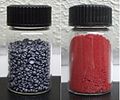Chalcogens
|
Position in the periodic table
|
|||||||||||||||||||||||||||||||||||||||||||||||||||||||||||||||||||||||||||||||||||||||||||||||||||||||||||||||||||||||||||||||||||||||||||||||||||||||||||||||||||||||||||||||||||||||||||||||||||||||||||||||||||||||||||||||||
| group | 16 |
| Main group | 6th |
| period | |
| 2 |
8 O |
| 3 |
16 pp |
| 4th |
34 Se |
| 5 |
52 te |
| 6th |
84 Po |
| 7th |
116 Lv |
The elements of the 6th main group of the periodic table are called chalcogens (literally "ore formers", from ancient Greek χαλκός chalkós "ore, metal, [especially:] copper , bronze " and γεννάω gennáo "produce"). The group is also called the oxygen group after the first element . According to the more recent numbering of the IUPAC the groups it is the group 16. At this group of substances are the elements oxygen , sulfur , selenium , tellurium , polonium , and the artificially produced Livermorium .
Occurrence
The chalcogens mostly occur in nature in the form of ores and minerals . The most common metal chalcogenides are oxides and sulfides . Examples of oxides are the gaseous carbon dioxide in the earth's atmosphere and solid silicon dioxide (e.g. crystalline as quartz ), which is the main component of the earth's crust . The sulfides include u. a. the minerals galena , cinnabar , pyrite , zinc sulfide and copper pebbles . Rare are selenides such. B. copper selenide and the tellurides such. B. Silver telluride. Some polonids are also stable, but a strongly decreasing stability has been predicted for livermorides . There are also other metal-chalcogen compounds such as B. the sulfites , sulfates and selenates .
Oxygen and sulfur also occur in elemental form (oxygen as a component of the air and dissolved in water , sulfur often in connection with volcanic exhalations , which contain hydrogen sulfide and sulfur dioxide and react to sulfur, and also sulfuric acid ).
properties
Physical Properties
The chalcogens of low atomic number are non-metals , whereby metallic modifications of selenium and tellurium also exist: selenium and tellurium are basically semimetals , polonium and livermorium metals . The physical properties are graded according to increasing atomic mass . From oxygen to tellurium, the density , melting and boiling points increase.
Chemical properties
Chalcogens react with metals to form earthy and sometimes also basic metal chalcogenides ( oxides , sulfides , etc.). They react with hydrogen to form hydrogen chalcogen: water , hydrogen sulfide , hydrogen selenide and hydrogen telluride , the compounds having analogous empirical formulas , H 2 X. However, hydrogen polonium already tends to be a hydride rather than a polonide , and confirmation of this trend is predicted for livermorium hydrogen . At the latest LvH 2 must be viewed as a hydride instead of a livermorid.
Chalcogens also form compounds with one another, e.g. B. the sulfur oxides or the selenium sulfides . Chalcogen oxides form with water along acids: the sulfur dioxide , the selenous acid and tellurous acid (would also be conceivable Polonige acid and Livermorige acid ) (molecular formula H 2 XO 3 ) from the dioxides and sulfuric acid , selenious acid , telluric acid , polonium acid and Livermoriumsäure ( Molecular formula H 2 XO 4 ) from the trioxides.
- The chalcogens
Oxygen in a discharge tube
Web links
Individual evidence
- ^ Brockhaus ABC Chemie , VEB FA Brockhaus Verlag Leipzig 1965, p. 217.




